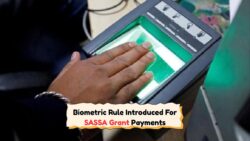Biometric Verification for SASSA 2025: The South African Social Security Agency (SASSA) is stepping into the future with the implementation of a biometric verification system by 2025. This advanced system aims to streamline the disbursement of grants, ensuring that beneficiaries receive their funds securely and efficiently. As the country continues to embrace digital transformation, incorporating biometric technology offers a robust solution to counter fraud and improve service delivery. For recipients, this means a quick and seamless process when accessing their grants, significantly reducing wait times and administrative hurdles. Understanding how this system will work and its implications is crucial for every SASSA beneficiary in South Africa.

Understanding the Need for Biometric Verification in SASSA 2025
In recent years, the need for enhanced security measures within social grant systems has become increasingly apparent in South Africa. With the rising instances of fraud and identity theft, SASSA’s move towards biometric verification in 2025 is both timely and necessary. Biometric verification uses unique biological characteristics, such as fingerprints or facial recognition, to authenticate an individual’s identity. This technology is not only more secure but also more convenient for users, eliminating the need for multiple forms of identification. As SASSA prepares to roll out this system, it anticipates a significant reduction in fraudulent activities, ensuring that grants reach the rightful recipients. For beneficiaries, this means added security and a smoother process when accessing their grants. The transition to biometrics represents a significant milestone in the agency’s efforts to improve service delivery and protect the interests of South African citizens.
How Biometric Verification Will Change SASSA Grant Collection
The introduction of biometric verification in SASSA’s grant collection process will usher in a new era of efficiency and security. By 2025, beneficiaries will experience a streamlined system where their identity is verified quickly through biometric data such as fingerprints or facial scans. This system reduces the risk of fraudulent claims and ensures that grants are only collected by the rightful recipients. For many South Africans relying on these grants, the new process will mean fewer complications and faster access to their funds. Additionally, the biometric system will help SASSA maintain accurate records, further enhancing service delivery and accountability. The transition to this technology may require beneficiaries to initially register their biometric data with SASSA, but the long-term benefits include a more reliable and user-friendly experience. This initiative aligns with global trends in digital identity verification and positions SASSA as a forward-thinking agency committed to safeguarding citizens’ welfare.
Preparing for the Transition to Biometric Systems
As SASSA moves towards implementing biometric verification by 2025, beneficiaries need to prepare for this transition. Understanding the requirements and process involved is essential to ensure a smooth switch to the new system. Initially, beneficiaries will be required to register their biometric data at designated SASSA offices or through authorized agents. This registration process will involve capturing fingerprints, facial images, or other biometric identifiers, which will then be securely stored within the SASSA database. Beneficiaries should ensure that their documentation is up-to-date and that they are informed about the registration schedules to avoid any disruptions in receiving their grants. SASSA plans to conduct widespread awareness campaigns to educate the public about the benefits and procedures of the new system. By staying informed and proactive, beneficiaries can contribute to a successful transition and continue to receive their grants without any hitches.
Benefits and Challenges of Implementing Biometric Verification for SASSA
The implementation of biometric verification by SASSA in 2025 promises numerous benefits, but also presents certain challenges that need to be addressed. One of the primary advantages is the increased security and accuracy in verifying beneficiaries’ identities, which will drastically reduce cases of fraud. The system’s efficiency ensures that grant disbursement is more streamlined, benefiting millions of South Africans who depend on these funds. However, challenges such as ensuring the privacy and protection of biometric data, as well as the initial costs of setting up the system, must be considered. Training personnel and educating beneficiaries about the new process are also crucial steps in overcoming these challenges. Despite these hurdles, the long-term benefits of biometric verification, including enhanced security and improved service delivery, make it a worthwhile investment for SASSA and its beneficiaries. As the agency navigates these challenges, it remains committed to providing secure and efficient access to social grants for all South Africans.




